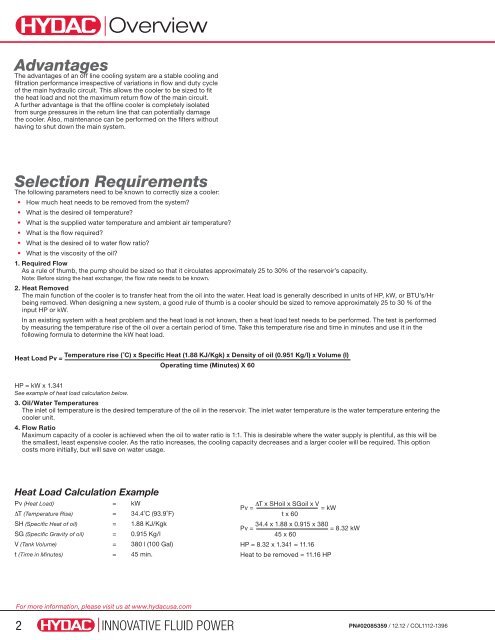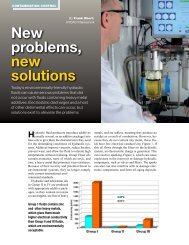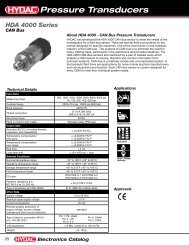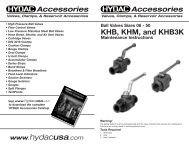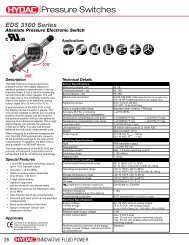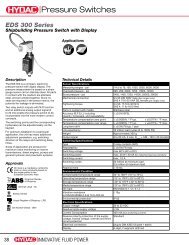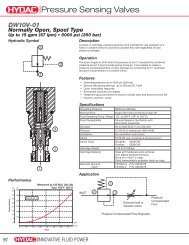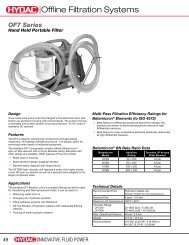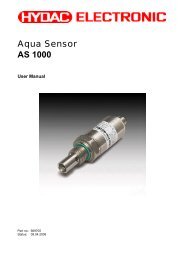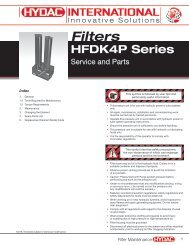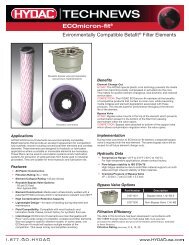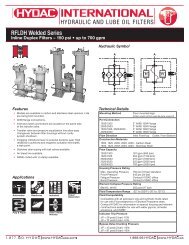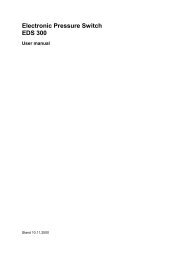Cooling Systems - HYDAC USA
Cooling Systems - HYDAC USA
Cooling Systems - HYDAC USA
Create successful ePaper yourself
Turn your PDF publications into a flip-book with our unique Google optimized e-Paper software.
Overview<br />
Advantages<br />
The advantages of an off line cooling system are a stable cooling and<br />
filtration performance irrespective of variations in flow and duty cycle<br />
of the main hydraulic circuit. This allows the cooler to be sized to fit<br />
the heat load and not the maximum return flow of the main circuit.<br />
A further advantage is that the offline cooler is completely isolated<br />
from surge pressures in the return line that can potentially damage<br />
the cooler. Also, maintenance can be performed on the filters without<br />
having to shut down the main system.<br />
Selection Requirements<br />
The following parameters need to be known to correctly size a cooler:<br />
• How much heat needs to be removed from the system<br />
• What is the desired oil temperature<br />
• What is the supplied water temperature and ambient air temperature<br />
• What is the flow required<br />
• What is the desired oil to water flow ratio<br />
• What is the viscosity of the oil<br />
1. Required Flow<br />
As a rule of thumb, the pump should be sized so that it circulates approximately 25 to 30% of the reservoir’s capacity.<br />
Note: Before sizing the heat exchanger, the flow rate needs to be known.<br />
2. Heat Removed<br />
The main function of the cooler is to transfer heat from the oil into the water. Heat load is generally described in units of HP, kW, or BTU’s/Hr<br />
being removed. When designing a new system, a good rule of thumb is a cooler should be sized to remove approximately 25 to 30 % of the<br />
input HP or kW.<br />
In an existing system with a heat problem and the heat load is not known, then a heat load test needs to be performed. The test is performed<br />
by measuring the temperature rise of the oil over a certain period of time. Take this temperature rise and time in minutes and use it in the<br />
following formula to determine the kW heat load.<br />
Heat Load Pv =<br />
Temperature rise (˚C) x Specific Heat (1.88 KJ/Kgk) x Density of oil (0.951 Kg/l) x Volume (l)<br />
Operating time (Minutes) X 60<br />
HP = kW x 1.341<br />
See example of heat load calculation below.<br />
3. Oil/Water Temperatures<br />
The inlet oil temperature is the desired temperature of the oil in the reservoir. The inlet water temperature is the water temperature entering the<br />
cooler unit.<br />
4. Flow Ratio<br />
Maximum capacity of a cooler is achieved when the oil to water ratio is 1:1. This is desirable where the water supply is plentiful, as this will be<br />
the smallest, least expensive cooler. As the ratio increases, the cooling capacity decreases and a larger cooler will be required. This option<br />
costs more initially, but will save on water usage.<br />
Heat Load Calculation Example<br />
Pv (Heat Load) = kW<br />
∆T (Temperature Rise) = 34.4˚C (93.9˚F)<br />
SH (Specific Heat of oil) = 1.88 KJ/Kgk<br />
SG (Specific Gravity of oil) = 0.915 Kg/l<br />
V (Tank Volume) = 380 l (100 Gal)<br />
t (Time in Minutes) = 45 min.<br />
Pv = ∆T x SHoil x SGoil x V = kW<br />
t x 60<br />
Pv = 34.4 x 1.88 x 0.915 x 380 = 8.32 kW<br />
45 x 60<br />
HP = 8.32 x 1.341 = 11.16<br />
Heat to be removed = 11.16 HP<br />
For more information, please visit us at www.hydacusa.com<br />
2 INNOVATIVE FLUID POWER<br />
PN#02085359 / 12.12 / COL1112-1396


